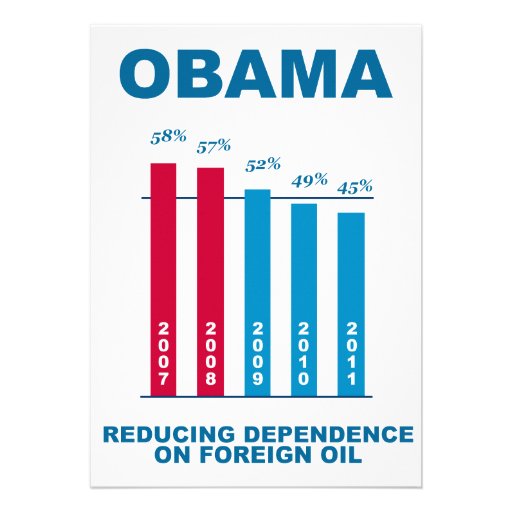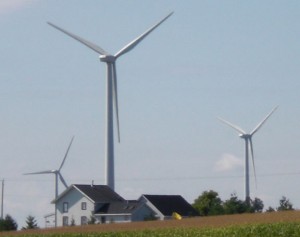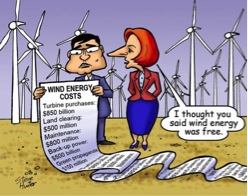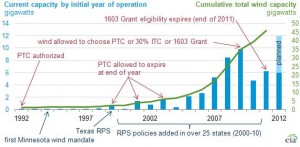Although wind turbines are unarguably much more environmental friendly than diesel fuel or natural gas, why isn’t the entire American costal shores cramped with this seemingly harmless and profitable source of renewable energy? Surely the cost of constructing this intricate and gigantic piece of machinery plays a major role in this setback. Even though this source of energy is “feasible to meet its goal of 20% of the total energy requirements by 2030, [it] will involve extensive research programs in various aspects such as design, manufacturing, installation, and operation & maintenance” (Lapire). In the end, however, it is an investment that is worth the American’s tax dollars in the long run. The biggest fear that is keeping Americans away from fully embracing wind turbines is actually the fear of the potential and unknown health-related effects of wind turbine farms to its nearby citizens. Although wind turbines obviously produce many “unwanted” by-products, these by-products do not harm the human body in any proven and scientific manner and they are also much healthier and harmless compared to the large amount of carbon dioxide and other greenhouse gases produced by the burning of diesel and natural gas.
The major concerns caused by wind turbines can be divided into four categories: noise, vibration, and light flicker. Furthermore, the magnitude of these side effects varies depending on the type and location of the wind turbines. “While noise levels for small wind turbines are typically much lower than for large wind turbines, their closer proximity to dwellings and business properties may increase the likelihood of noise annoyance resulting in reported physical and psychological ill-health” (Taylor). Therefore the size of the wind turbine can alter the noise level that it produces, with its volume directly relating to its size; at the same time, its distance away from the surrounding people also play a role, with its volume inversely proportional to the distance away. While this is only addressing the noise aspect of the wind turbine, all of the features I mentioned previously also behave similarly, including vibration and light flicker. This increases the complexity of measuring the amount of disturbance caused by the wind turbines in the different regions of the country. To further complicate the issue, different individuals are affected in different manners when in the presence of such disturbances. Some tend to believe that people’s well-beings can be somehow damaged by the mere presence of wind turbines, and they coined such “damage” as the Wind Turbine Syndrome (Pederson).
The most obvious and, arguably, the most damaging by-product of wind turbines and wind farms is the unwanted sound generated by the turbine during its operation. Even though “the sound power level of a typical modern utility scale wind turbine is on the order of 103 dB,” “at distances larger than 400 m, sound pressure levels for modern wind turbines are less than 40 dB” (Ellenbogen). Sounds with pressure levels of around 40 dB is “below the level associated with annoyance in the epidemiological studies reviewed” (Ellenbogen). This means people living at least four hundred meters away from the turbines cannot be disturbed by it at all. This can easily be arranged so that all wind turbines are built at least four hundred to five hundred meters away from the nearest household.
The kind of vibration produced by wind turbines is called infrasound, which are vibrations with frequencies below 20 Hz. Out of these types of vibrations, only the ones with amplitudes higher than 100 dB can be heard or felt. According to the Massachusetts Department of Public Health, “the highest infrasound levels that have been measured near turbines and reported in the literature near turbines are under 90 dB at 5 Hz and lower at higher frequencies for locations as close as 100 m” (Ellenbogen). This means only people living within one hundred meters of the wind turbine can feel the infrasound produced by the wind turbine. This, again, can easily be solved if we simply secure more than four hundred meters of space between the turbines and the nearest housings.
Shadow flicker, the last major concern for nearby wind turbine dwellers, is believed by many to have the potential to cause epileptic seizures. Several reports of seizures have indeed been reported by people living within close proximity of wind farms. However, there is absolutely no proof been collected by researchers that state these cases are indeed related to the shadow flicker caused by the wind turbines. In fact, the opposite has been proven by many studies, including the one conducted by Mass Gov and another by Andrew Smedley, of University of Manchester. According to Smedley, “large wind turbines rotate at a rate below that at which the flicker is likely to present a risk,” and even though small blades rotating at a faster pace pose a threat to people’s health, the risk is “negligible at a distance more than about nine times the maximum height reached by the turbine blade” (Smedley). Once again, the problem can easily be avoided by building turbines at a certain distances away from its citizens.
Even though it is nearly impossible to “measure” the amount of damage wind turbines can potentially cause to its nearby dwellers, it is clear that most of the concerns that lead to the potential causes of Wind Turbine Syndromes are completely negligible when the turbines are built within an appropriate distance. The side effects of a wind turbine experienced by a typical and common household near the facility, at its worst, “is not sufficient to cause hearing impairment or other direct health effects, although some people may find it annoying” (Havas). The laws and regulations made in the future regarding to the constructions of wind turbines, therefore, must take into account of this distancing in order to fully make sure windiness are not only environmentally friendly, but also safe for everyone.
Work Cited:
Lapira, Edzel. “Wind Turbine Performance Assessment Using Multi-regime Modeling Approach.” Renewable Energy. Cincinnati: Elsevier, 2012. N. pag. Print.
Taylor, Jennifer. “The Influence of Negative Oriented Personality Traits on the Effects of Wind Turbine Noise.” Personality and Individual Differences. Vol. 54. Nottingham: Elsevier, n.d. 338-43. Print. Ser. 3.
McCubbin, Donald, and Benjamin K. Sovacool. “Quantifying the Health and Environmental Benefits of Wind Power to Natural Gas.” Energy Policy (2012): n. pag. Elsevier. Web. 3 Dec. 2012.
Havas, Magda, and David Colling. “Wind Turbines Make Waves : Why Some Residents Near Wind Turbines Become Ill.” Http://bst.sagepub.com/ Bulletin of Science, Technology & Society 31.5 (2011): 414-26. Sage. Web. 3 Dec. 2012.
Pederson, Eja. “Health Aspects Associated with Wind Turbine Noise: Results from Three Field Studies.” Institute of Noise Control Engineering 59.1 (2011): 47-53. Web. 3 Dec. 2012.
Ellenbogen, Jeffrey M. “Wind Turbine Health Impact Study: Report of Independent Expert Panel.” Massachusetts Department of Public Health (2011): n. pag. Web. 3 Dec. 2012.
Kusiak, Andrew, and Wenyan Li. “The Prediction and Diagnosis of Wind Turbine Faults.”Renewable Energy 36.1 (2011): 16-23. Elsevier. Web. 3 Dec. 2012.
Smedley, Andrew R.D. “Potential of Wind Turbines to Elicit Seizures under Various Meteorological Conditions.” Webofknowledge.com. Web of Science, July 2010. Web. 03 Dec. 2012. <http://apps.webofknowledge.com/InboundService.do?SID=3BgIbpagiLDm1E2ehO@>.





